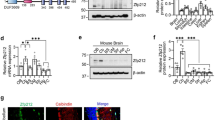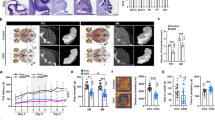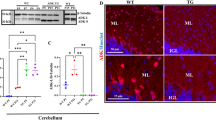Abstract
HOMOZYGOUS staggerer (sg) mice show a characteristic severe cerebellar ataxia due to a cell-autonomous defect in the development of Purkinje cells1,2. These cells show immature morphology, synaptic arrangement, biochemical properties and gene expression, and are reduced in numbers3–12. In addition, sg heterozygotes show accelerated dendritic atrophy and cell loss13, suggesting that sg has a role in mature Purkinje cells. Effects of this mutation on cerebellar development have been studied for 25 years, but its molecular basis has remained unknown. We have genetically mapped staggerer to an interval of 160 kilobases on mouse chromosome 9 which was found to contain the gene encoding RORα, a member of the nuclear hormone-receptor superfamily. Staggerer mice were found to carry a deletion within the RORα gene that prevents translation of the ligand-binding homology domain. We propose a model based on these results, in which RORα interacts with the thyroid hormone signalling pathway to induce Purkinje-cell maturation.
This is a preview of subscription content, access via your institution
Access options
Subscribe to this journal
Receive 51 print issues and online access
$199.00 per year
only $3.90 per issue
Buy this article
- Purchase on Springer Link
- Instant access to full article PDF
Prices may be subject to local taxes which are calculated during checkout
Similar content being viewed by others
References
Sidman, R. L., Lane, P. W. & Dickie, M. M. Science 137, 610–612 (1962).
Herrup, K. & Mullen, R. J. Brain Res. 178, 443–457 (1979).
Sotelo, C. & Changeux, J.-P. Brain Res. 67, 519–526 (1974).
Sotelo, C. Adv. Neurol. 12, 335–351 (1975).
Crepel, F., Delhaye-Bouchaud, N., Guastavino, J. M. & Sampaio, I. Nature 283, 483–484 (1980).
Landis, D. M. & Sidman, R. L. J. comp. Neurol. 179, 831–863 (1978).
Mariani, J. & Changeux, J.-P. J. Neurobiol. 11, 41–50 (1980).
Hatten, M. E. & Messer, A. Nature 276, 504–506 (1978).
Trenkner, E. Nature 277, 566–567 (1979).
Edelman, G. M. & Chuong, C. M. Proc. natn. Acad. Sci. U.S.A. 79, 7036–7040 (1982).
Herrup. K. & Müllen, R. J. Brain Res. 227, 475–485 (1981).
Herrup. K. Brain Res. 313, 267–274 (1983).
Zanjani, H. S., Mariani, J., Delhaye-Bouchaud, N. & Herrup, K. Brain Res. Dev. 67, 153–160 (1992).
Dietrich, W. F. et al. Nature Genet. 7, 220–245 (1994).
Kusumi, K., Smith, J. S., Segre J. A., Koos, D. S. & Lander, E. S. Mamm. Genome 4, 391–392 (1993).
Becker-André, M., André, E. & DeLamarter, J. F. Biochem. Biophys. Res. Commun. 194, 1371–1379 (1993).
Giguere, V. et al. Genes Dev. 8, 538–553 (1994).
Giguere, V., McBroom, L. D. & Flock, G. Molec. cell. Biol. 15, 2517–2526 (1995).
McBroom, L. D., Flock, G. & Giguere, V. Molec. cell. Biol. 15, 796–808 (1995).
Herrup, K. & Mullen. R. J. Brain Res. 172, 1–12 (1979).
Hatten, M. E. & Heintz, N. A. Rev. Neurosci. 18, 385–408 (1995).
Trenkner, E. & Hoffmann, M. K. J. Neurosci. 6, 1733–1737 (1986).
Legrand, J. Trends Neurosci. 2, 234–236 (1979).
Messer, A. J. Neurochem. 51, 888–891 (1988).
Zou, L., Hagen, S. G., Strait, K. A. & Oppenheimer, J. H. J. biol. Chem. 269, 13346–13352 (1994).
Tini, M., Tsui, L. C. & Giguere, V. Molec. Endocr. 8, 1494–1506 (1994).
Forman, B. M. et al. Molec. Endocr. 8, 1253–1261 (1994).
Tini, M., Fraser, R. A. & Giguere, V. J. biol. Cnem. 270, 20156–20161 (1995).
Forman, B. M., Umesono, K., Chen, J. & Evans, R. M. Cell 81, 541–550 (1995).
Sambrook, J., Fritsch, E. F. & Maniatis, T. Molecular Cloning; A Laboratory Manual (Cold SpringHarbor Laboratory Press, Cold Spring Harbor, New York, 1989).
Author information
Authors and Affiliations
Rights and permissions
About this article
Cite this article
Hamilton, B., Frankel, W., Kerrebrock, A. et al. Disruption of the nuclear hormone receptor RORα in staggerer mice. Nature 379, 736–739 (1996). https://doi.org/10.1038/379736a0
Received:
Accepted:
Issue Date:
DOI: https://doi.org/10.1038/379736a0
This article is cited by
-
RORα inhibits gastric cancer proliferation through attenuating G6PD and PFKFB3 induced glycolytic activity
Cancer Cell International (2024)
-
Brain nuclear receptors and cardiovascular function
Cell & Bioscience (2023)
-
The Cerebellar Gene Database: a Collective Database of Genes Critical for Cerebellar Development
The Cerebellum (2022)
Comments
By submitting a comment you agree to abide by our Terms and Community Guidelines. If you find something abusive or that does not comply with our terms or guidelines please flag it as inappropriate.



